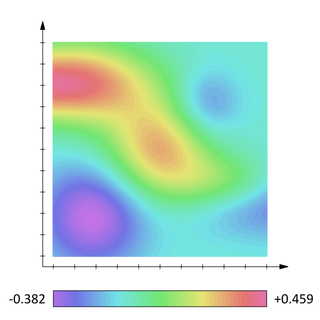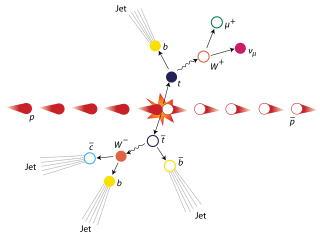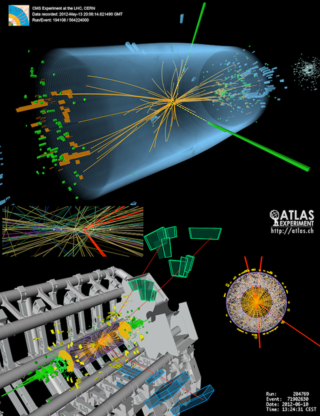Related Research Articles

In particle physics, the electroweak interaction or electroweak force is the unified description of two of the four known fundamental interactions of nature: electromagnetism (electromagnetic interaction) and the weak interaction. Although these two forces appear very different at everyday low energies, the theory models them as two different aspects of the same force. Above the unification energy, on the order of 246 GeV, they would merge into a single force. Thus, if the temperature is high enough – approximately 1015 K – then the electromagnetic force and weak force merge into a combined electroweak force. During the quark epoch (shortly after the Big Bang), the electroweak force split into the electromagnetic and weak force. It is thought that the required temperature of 1015 K has not been seen widely throughout the universe since before the quark epoch, and currently the highest human-made temperature in thermal equilibrium is around 5.5x1012 K (from the Large Hadron Collider).

The Standard Model of particle physics is the theory describing three of the four known fundamental forces in the universe and classifying all known elementary particles. It was developed in stages throughout the latter half of the 20th century, through the work of many scientists worldwide, with the current formulation being finalized in the mid-1970s upon experimental confirmation of the existence of quarks. Since then, proof of the top quark (1995), the tau neutrino (2000), and the Higgs boson (2012) have added further credence to the Standard Model. In addition, the Standard Model has predicted various properties of weak neutral currents and the W and Z bosons with great accuracy.

In mathematics and physics, a scalar field is a function associating a single number to every point in a space – possibly physical space. The scalar may either be a pure mathematical number (dimensionless) or a scalar physical quantity.
Supersymmetry is a theoretical framework in physics that suggests the existence of a symmetry between particles with integer spin (bosons) and particles with half-integer spin (fermions). It proposes that for every known particle, there exists a partner particle with different spin properties. There have been multiple experiments on supersymmetry that have failed to provide evidence that it exists in nature. If evidence is found, supersymmetry could help explain certain phenomena, such as the nature of dark matter and the hierarchy problem in particle physics.

The top quark, sometimes also referred to as the truth quark, is the most massive of all observed elementary particles. It derives its mass from its coupling to the Higgs Boson. This coupling yt is very close to unity; in the Standard Model of particle physics, it is the largest (strongest) coupling at the scale of the weak interactions and above. The top quark was discovered in 1995 by the CDF and DØ experiments at Fermilab.

Technicolor theories are models of physics beyond the Standard Model that address electroweak gauge symmetry breaking, the mechanism through which W and Z bosons acquire masses. Early technicolor theories were modelled on quantum chromodynamics (QCD), the "color" theory of the strong nuclear force, which inspired their name.

Spontaneous symmetry breaking is a spontaneous process of symmetry breaking, by which a physical system in a symmetric state spontaneously ends up in an asymmetric state. In particular, it can describe systems where the equations of motion or the Lagrangian obey symmetries, but the lowest-energy vacuum solutions do not exhibit that same symmetry. When the system goes to one of those vacuum solutions, the symmetry is broken for perturbations around that vacuum even though the entire Lagrangian retains that symmetry.

In the Standard Model of particle physics, the Higgs mechanism is essential to explain the generation mechanism of the property "mass" for gauge bosons. Without the Higgs mechanism, all bosons (one of the two classes of particles, the other being fermions) would be considered massless, but measurements show that the W+, W−, and Z0 bosons actually have relatively large masses of around 80 GeV/c2. The Higgs field resolves this conundrum. The simplest description of the mechanism adds a quantum field (the Higgs field) which permeates all of space to the Standard Model. Below some extremely high temperature, the field causes spontaneous symmetry breaking during interactions. The breaking of symmetry triggers the Higgs mechanism, causing the bosons it interacts with to have mass. In the Standard Model, the phrase "Higgs mechanism" refers specifically to the generation of masses for the W±, and Z weak gauge bosons through electroweak symmetry breaking. The Large Hadron Collider at CERN announced results consistent with the Higgs particle on 14 March 2013, making it extremely likely that the field, or one like it, exists, and explaining how the Higgs mechanism takes place in nature. The view of the Higgs mechanism as involving spontaneous symmetry breaking of a gauge symmetry is technically incorrect since by Elitzur's theorem gauge symmetries can never be spontaneously broken. Rather, the Fröhlich–Morchio–Strocchi mechanism reformulates the Higgs mechanism in an entirely gauge invariant way, generally leading to the same results.
Alternative models to the Standard Higgs Model are models which are considered by many particle physicists to solve some of the Higgs boson's existing problems. Two of the most currently researched models are quantum triviality, and Higgs hierarchy problem.
A conformal anomaly, scale anomaly, trace anomaly or Weyl anomaly is an anomaly, i.e. a quantum phenomenon that breaks the conformal symmetry of the classical theory.
In particle physics, little Higgs models are based on the idea that the Higgs boson is a pseudo-Goldstone boson arising from some global symmetry breaking at a TeV energy scale. The goal of little Higgs models is to use the spontaneous breaking of such approximate global symmetries to stabilize the mass of the Higgs boson(s) responsible for electroweak symmetry breaking.
The Coleman–Weinberg model represents quantum electrodynamics of a scalar field in four-dimensions. The Lagrangian for the model is

William Allan Bardeen is an American theoretical physicist who worked at the Fermi National Accelerator Laboratory. He is renowned for his foundational work on the chiral anomaly, the Yang-Mills and gravitational anomalies, the development of quantum chromodynamics and the scheme frequently used in perturbative analysis of experimentally observable processes such as deep inelastic scattering, high energy collisions and flavor changing processes.

Christopher T. Hill is an American theoretical physicist at the Fermi National Accelerator Laboratory who did undergraduate work in physics at M.I.T., and graduate work at Caltech. Hill's Ph.D. thesis, "Higgs Scalars and the Nonleptonic Weak Interactions" (1977) contains one of the first detailed discussions of the two-Higgs-doublet model and its impact upon weak interactions. His work mainly focuses on new physics that can be probed in laboratory experiments or cosmology.
Topcolor is a model in theoretical physics, of dynamical electroweak symmetry breaking in which the top quark and anti-top quark form a composite Higgs boson by a new force arising from massive "top gluons". The solution to composite Higgs models was actually anticipated in 1981, and found to be the Infrared fixed point for the top quark mass.

The Higgs boson, sometimes called the Higgs particle, is an elementary particle in the Standard Model of particle physics produced by the quantum excitation of the Higgs field, one of the fields in particle physics theory. In the Standard Model, the Higgs particle is a massive scalar boson with zero spin, even (positive) parity, no electric charge, and no colour charge that couples to mass. It is also very unstable, decaying into other particles almost immediately upon generation.
The 1964 PRL symmetry breaking papers were written by three teams who proposed related but different approaches to explain how mass could arise in local gauge theories. These three papers were written by: Robert Brout and François Englert; Peter Higgs; and Gerald Guralnik, C. Richard Hagen, and Tom Kibble (GHK). They are credited with the theory of the Higgs mechanism and the prediction of the Higgs field and Higgs boson. Together, these provide a theoretical means by which Goldstone's theorem can be avoided. They showed how gauge bosons can acquire non-zero masses as a result of spontaneous symmetry breaking within gauge invariant models of the universe.
In particle physics, W′ and Z′ bosons refer to hypothetical gauge bosons that arise from extensions of the electroweak symmetry of the Standard Model. They are named in analogy with the Standard Model W and Z bosons.
Bumblebee models are effective field theories describing a vector field with a vacuum expectation value that spontaneously breaks Lorentz symmetry. A bumblebee model is the simplest case of a theory with spontaneous Lorentz symmetry breaking.

Superfluid vacuum theory (SVT), sometimes known as the BEC vacuum theory, is an approach in theoretical physics and quantum mechanics where the fundamental physical vacuum is considered as a superfluid or as a Bose–Einstein condensate (BEC).
References
- ↑ Steven Weinberg (1976), "Implications of dynamical symmetry breaking", Physical Review D, 13 (4): 974–996, Bibcode:1976PhRvD..13..974W, doi:10.1103/PhysRevD.13.974.
S. Weinberg (1979), "Implications of dynamical symmetry breaking: An addendum", Physical Review D, 19 (4): 1277–1280, Bibcode:1979PhRvD..19.1277W, doi:10.1103/PhysRevD.19.1277. - ↑ Leonard Susskind (1979), "Dynamics of spontaneous symmetry breaking in the Weinberg-Salam theory", Physical Review D, 20 (10): 2619–2625, Bibcode:1979PhRvD..20.2619S, doi:10.1103/PhysRevD.20.2619, OSTI 1446928.
- ↑ Weinberg, Erick J. (2015-07-15). "Coleman-Weinberg mechanism". Scholarpedia. 10 (7): 7484. Bibcode:2015SchpJ..10.7484W. doi: 10.4249/scholarpedia.7484 . ISSN 1941-6016.
- ↑ Stancato, David; Terning, John (2009). "The Unhiggs". Journal of High Energy Physics. 0911 (11): 101. arXiv: 0807.3961 . Bibcode:2009JHEP...11..101S. doi:10.1088/1126-6708/2009/11/101. S2CID 17512330.
- ↑ Falkowski, Adam; Perez-Victoria, Manuel (2009). "Electroweak Precision Observables and the Unhiggs". Journal of High Energy Physics. 0912 (12): 061. arXiv: 0901.3777 . Bibcode:2009JHEP...12..061F. doi:10.1088/1126-6708/2009/12/061. S2CID 17570408.
- ↑ Dvali, Gia; Giudice, Gian F.; Gomez, Cesar; Kehagias, Alex (2011). "UV-Completion by Classicalization". Journal of High Energy Physics. 2011 (8): 108. arXiv: 1010.1415 . Bibcode:2011JHEP...08..108D. doi:10.1007/JHEP08(2011)108. S2CID 53315861.
- ↑ Goldfain, E. (2008). "Bifurcations and pattern formation in particle physics: An introductory study". EPL. 82 (1): 11001. Bibcode:2008EL.....8211001G. doi:10.1209/0295-5075/82/11001. S2CID 62823832.
- ↑ Goldfain, E. (2010). "Non-equilibrium Dynamics as Source of Asymmetries in High Energy Physics" (PDF). Electronic Journal of Theoretical Physics. 7 (24): 219–234. Archived from the original (PDF) on 2022-01-20. Retrieved 2012-07-10.
- ↑ Calmet, X. (2011), "Asymptotically safe weak interactions", Modern Physics Letters A, 26 (21): 1571–1576, arXiv: 1012.5529 , Bibcode:2011MPLA...26.1571C, CiteSeerX 10.1.1.757.7245 , doi:10.1142/S0217732311035900, S2CID 118712775
- ↑ Calmet, X. (2011), "An Alternative view on the electroweak interactions", International Journal of Modern Physics A, 26 (17): 2855–2864, arXiv: 1008.3780 , Bibcode:2011IJMPA..26.2855C, CiteSeerX 10.1.1.740.5141 , doi:10.1142/S0217751X11053699, S2CID 118422223
- ↑ Codello, A.; Percacci, R. (2009), "Fixed Points of Nonlinear Sigma Models in d>2", Physics Letters B, 672 (3): 280–283, arXiv: 0810.0715 , Bibcode:2009PhLB..672..280C, doi:10.1016/j.physletb.2009.01.032, S2CID 119223124
- ↑ Abbott, L. F.; Farhi, E. (1981), "Are the Weak Interactions Strong?", Physics Letters B , 101 (1–2): 69, Bibcode:1981PhLB..101...69A, CiteSeerX 10.1.1.362.4721 , doi:10.1016/0370-2693(81)90492-5
- ↑ Csaki, C.; Grojean, C.; Pilo, L.; Terning, J. (2004), "Towards a realistic model of Higgsless electroweak symmetry breaking", Physical Review Letters , 92 (10): 101802, arXiv: hep-ph/0308038 , Bibcode:2004PhRvL..92j1802C, doi:10.1103/PhysRevLett.92.101802, PMID 15089195, S2CID 6521798
- ↑ Csaki, C.; Grojean, C.; Murayama, H.; Pilo, L.; Terning, John (2004), "Gauge theories on an interval: Unitarity without a Higgs", Physical Review D , 69 (5): 055006, arXiv: hep-ph/0305237 , Bibcode:2004PhRvD..69e5006C, doi:10.1103/PhysRevD.69.055006, S2CID 119094852
- ↑ Calmet, X.; Deshpande, N. G.; He, X. G.; Hsu, S. D. H. (2009), "Invisible Higgs boson, continuous mass fields and unHiggs mechanism", Physical Review D, 79 (5): 055021, arXiv: 0810.2155 , Bibcode:2009PhRvD..79e5021C, doi:10.1103/PhysRevD.79.055021, S2CID 14450925
- ↑ Pawlowski, M.; Raczka, R. (1994), "A Unified Conformal Model for Fundamental Interactions without Dynamical Higgs Field", Foundations of Physics, 24 (9): 1305–1327, arXiv: hep-th/9407137 , Bibcode:1994FoPh...24.1305P, doi:10.1007/BF02148570, S2CID 17358627
- ↑ Bilson-Thompson, Sundance O.; Markopoulou, Fotini; Smolin, Lee (2007), "Quantum gravity and the standard model", Classical and Quantum Gravity, 24 (16): 3975–3993, arXiv: hep-th/0603022 , Bibcode:2007CQGra..24.3975B, doi:10.1088/0264-9381/24/16/002, S2CID 37406474.
- ↑ V. Avdeenkov, Alexander; G. Zloshchastiev, Konstantin (2011). "Quantum Bose liquids with logarithmic nonlinearity: Self-sustainability and emergence of spatial extent". Journal of Physics B. 44 (19): 195303. arXiv: 1108.0847 . Bibcode:2011JPhB...44s5303A. doi:10.1088/0953-4075/44/19/195303. S2CID 119248001.
- ↑ G. Zloshchastiev, Konstantin (2011). "Spontaneous symmetry breaking and mass generation as built-in phenomena in logarithmic nonlinear quantum theory". Acta Physica Polonica B. 42 (2): 261–292. arXiv: 0912.4139 . Bibcode:2011AcPPB..42..261Z. doi:10.5506/APhysPolB.42.261. S2CID 118152708.
- ↑ Dzhunushaliev, Vladimir; G. Zloshchastiev, Konstantin (2013). "Singularity-free model of electric charge in physical vacuum: Non-zero spatial extent and mass generation". Cent. Eur. J. Phys. 11 (3): 325–335. arXiv: 1204.6380 . Bibcode:2013CEJPh..11..325D. doi:10.2478/s11534-012-0159-z. S2CID 91178852.